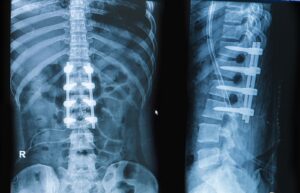
Chiropractic adjustments can help with so much, from aches and pains to help restore motion or address specific conditions. While chiropractic care is generally safe for most people, there are a few circumstances or conditions for which an adjustment is NOT RECOMMENDED.
We can help in other ways—read all the way to the end to find out how.
Osteoporosis weakens the bones (and can make them lacy in appearance). Patients with severe osteoporosis (when one has a T score of -2.5 with a DEXA, or a bone scan) are prone to have bone fractures. The pressure that is put on the body during an adjustment, even in a small amount, could cause a fracture. Gentleness is critical with osteoporotic patients.
The most significant risk with spine cancer is a fracture. When a patient has any kind of spinal cancer, it can weaken the bones and make them more prone to fracture. Some spinal cancers begin in the spine (primary), while others can metastasize from another area with cancer (secondary), like the breast or the prostate. It’s essential to keep tabs on the location of your cancer and the health of your spine. It’s best to avoid spinal adjustments.
If you have a broken bone, visit the emergency room or your primary health care provider. While chiropractors can often provide an x-ray, chiropractors do not deal in broken bones, and to try to adjust or move bones that are trying to heal would be completely counterintuitive. (But we’ll certainly sign your cast!)
All of your blood and lymph vessels make up your vascular system. Adjustments are not recommended when it’s weakened by specific conditions such as a previous stroke or an artery dissection.
This often-congenital condition results from a smaller or misshapen skull that causes the back of the brain (cerebellum) to push down into the spinal cord. Adjustments of the spine are a big no-no here.
Certain bone conditions are very sensitive to touch and movement. Adjustments are not recommended for the following specific bone conditions:
Trauma or other certain conditions may cause instability—the bones in the joints are moving more than they should (like a wobbly building).
If it has been a while after your joint replacement, chiropractic adjustments may be okay with your doctor’s go-ahead. However, in the first 3-6 months after the joint replacement, it’s best to give your body time to stabilize the new joint, so the replacement hardware doesn’t shift. However, the other areas of your body not connected to your recently replaced joint can be adjusted.


Most of these conditions preclude physical or manual adjustments, wherein the chiropractor uses their hand or a chiropractic table. Instrument adjusting, however, which is gentle, can be safe for many patients with the conditions listed above—as long as it is applied in a lower amplitude to the body in a neutral position.
Chiropractors also offer soft tissue mobilization, including massage, stretching, and other applications so that you can have the benefit of relaxed muscles, even without an adjustment.
It is essential to let your doctor know about any new symptoms, or changes in health and procedures so that he or she can determine if your current care plan is the best for you.
Copyright @2025 Element Chiropractic — 875 SW Rimrock Way Suite 103, Redmond, OR 97756